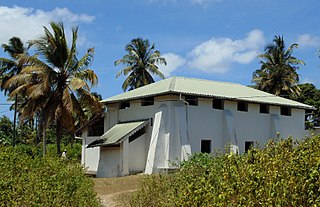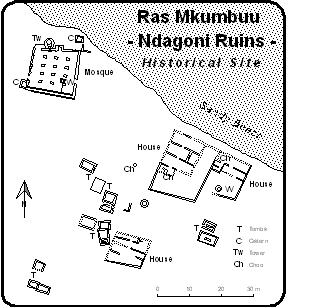
Mikindani is a historic coastal town located in Mtwara-Mikindani District of Mtwara Region in Tanzania. The name comes from the Swahili word mikinda which means "young coconut trees". Therefore, the term "Mikindani', literally means "the place where there are young coconut trees" in old Swahili language. Mikindani is part of the city of Mtwara and is governed by the Mtwara Mikindani Municipal Council. The site is a registered National Historic Site.

The Kizimkazi Dimbani Mosque is a mosque Located in the town of Dimbani, Kusini District of Unguja South Region in Tanzania. It is situated on the southern tip of the island of Zanzibar in Tanzania and is one of the oldest Islamic buildings on the East African coast. Despite its name, it is located in Dimbani, not Kizimkazi, which is 3 miles away. According to a preserved kufic inscription, it was built in 1107. Although the inscription and certain coral-carved decorative elements date from the period of construction, the majority of the present structure was rebuilt in the 18th century.
Chambani is a historic site and village located in Mkoani District of Pemba South Region. Its one of several National Historic sites on the island of Pemba. The site is located nine kilometres south of Chake-Chake, close to several sets of ruins, notably the Pujini Ruins, a 15th-century citadel, located close to the village of Pujini, two kilometres to the north.

Ras Mkumbuu Ruins are located in Chake Chake district of South Pemba Region. They lie close to the village of Ndagoni at the end of a long narrow peninsula known as Ras Mkumbuu, which lies to the northwest of the town of Chake-Chake. The ruins mainly date from the 9th century CE and were abandoned in the 16th century, though there are indications that they were built over older foundations. Notable among these ruins are those of a large mosque which was for some time the largest structure of its type in sub-Saharan Africa. James Kirkman, the first archeologist to excavate here in the 1950s, proposed to connect his findings with the "Qanbalu" mentioned by the Arab explorer Al-Masudi around 900 but could not identify remnants earlier than the 13th century . A possible identification of Pemba Island as a whole and especially Ras Mkumbuu with Qanbalu is still discussed.

Makunduchi is a historic town and district capital in the Kusini District of the Unguja South Region in Tanzania. It is located inside the Kajengwa ward, and Mtegani ward, occupying Kiongoni neighborhood, Nganani neighborhood and Kijini neighborhood. The town comprises two distinct settlements, about 2 km from each other, "Old Makunduchi" on the east and "New Makunduchi". Old Makunduchi is a small fishermen's village on the shore of the Indian Ocean with the Nganani mtaa (neighborhood), while New Makunduchi has some modern buildings, shops, as well as some blocks of flats that were built in the 1970s with the aid of East Germans in return for Tanzanian political support internationally. The town is also the birthplace and resting place for the 4th president of Zanzibar Idris Abdul Wakil. Makunduchi is also the birthplace of Samia Suluhu Hassan, the president of Tanzania. Other famous politicians for Makunduchi include Mohamed Gharib Bilal. Also famous novelist Muhammed Said Abdulla.
The Hadimu are a Bantu ethnic and linguistic group native to the islands of Zanzibar and Pemba Island of Tanzania.

Mkama Ndume Ruins was a medieval Swahili settlement palace ruins located in Chake Chake District of Pemba South Region that was abandoned in the 16th Century prior to Portuguese arrival and is known for its fortification. The site is located 10 km (6.2 mi) east of the town of Chake-Chake. The settlement was ruled by a leader named Mohammed bin Abdul Rahman, who was known for his cruelty towards his subjects thus earned his infamous nickname Mkama Ndume meaning milker of men in old Swahili. The settlement ruins bear this nickname.

Kilwa Kivinje Historic Site is a protected historic site located on Kilwa Kivinje ward in Kilwa District in Lindi Region of Tanzania's Indian Ocean coast. The site is home to medieval Swahili ruins and some surviving Swahili buildings from the late 19th century. The settlement is considered to be the refuge of the earlier inhabitants of Kilwa Kisiwani who had fled Vasco da Gama sacking of the city in 1505 and also absorbed more refugees fleeing the Madagascar pirates in 1822.

Pujini Ruins is a Medieval historic site next to the village of Pujini located in Chake Chake District of Pemba South Region. There used to be a fortified palace at the site, only ruins of the walls remain. The palace is believed to have been of Mkame Mdume. Its one of several National Historic Sites on the island of Pemba including Chambani and Ras Mkumbuu.

Chwaka is a medieval Swahili historic site next to the village of Chwaka located in Micheweni District of Pemba North Region, Tanzania. There is an excavated Swahili mosque on the site. The location of these ruins is 6 km (3.7 mi) from the small town of Konde, at the end of a trail that extends 900 m (3,000 ft) in the direction of the village of Tumbe on the way to the village of Myumoni.
Mtambwe Kuu or Mtambwe Mkuu is a Medieval Swahili historic site located in Chake Chake District of Pemba North Region. A town wall, a mosque, tombs, and residences are among the several stone constructions at the Mtambwe Mkuu site in northwest Pemba. The oldest indications of occupation date from the eleventh century and persisted successfully and unbrokenly until the fifteenth century. It was once again occupied in the nineteenth century. A cache of over 2,000 gold and silver coins from the 10 and eleventh centuries were found during an excavation at the location, demonstrating Pemba's Swahili involvement in the regional trade networks at the time.
Tumbe is an early Medieval Swahili historic site next to the village of Tumbe located in Micheweni District of Pemba North Region. Between 600 and 1000 AD, the city of Tumbe served as the island's primary location. There is sufficient evidence that this city served as a major commerce hub for the Indian Ocean. Smaller sites from the eighth to tenth centuries AD were grouped together around the major metropolis.

Msuka Mjini Ruins is a protected historic site located inside Micheweni District of Pemba North Region in Tanzania. Msuka Mjini has a Swahili mosque from the fifteenth century preserved in ruins on the Kigomasha peninsula on the island. The date 816AH is carved on the interior of the circular mirhab.
Kichokochwe is protected historic site located inside Wete District of Pemba North Region in Tanzania. The site is home to partially excavated abandoned late medieval Swahili ruins, with a mosque and tombs.
Mduuni Ruins is a protected historic site located inside Micheweni District of Pemba North Region in Tanzania. The settlement was established around 1100 CE.
Mkia wa Ng'ombe Ruins is a protected historic site located inside Micheweni District of Pemba North Region in Tanzania. The settlement was established around the 15th CE and abandoned in the 16th century. There are ruins of a mosque, tombs and some stone buildings. The site is critically endangered to further erosion.
Kisimani Mafia is a national historic site located in Miburani ward in the Mafia Archipelago of Pwani Region's Mafia District. They are Mafia's oldest ruins, which are close to the district's capital of Kilindoni. The earliest strata of mosques, according to archaeologist Neville Chittick who performed excavations there in the 1950s, date from about the tenth and eleventh centuries. However, many of them have since been washed into the Mafia Channel.

Lindi Historic Town is a historic area located in the present day small city of Lindi, Lindi Municipal District of Lindi Region in Tanzania. The historic part of town covers the wards of Makonde, Ndoro, Mikundi, Mitandi and Msanjihili wards. The area has building from Swahili, Arab and German tradition reflecting the settlement's history.

Kunduchi is a Medieval Swahili National Historic Site located in Kunduchi ward, located in Kinondoni District of Dar es Salaam Region in Tanzania. There is an excavated 15th-century mosque on the site. An 18th-century cemetery with the biggest collection of pillared tombs in East Africa, situated in a baobab woodland, and embellished with Ming era's porcelain plates. The pottery discovered here demonstrates the medieval town's affluence and trading connections with imperial China.

Kua or Ruins of Kua is a Medieval Swahili, National Historic Site located in Jibondo ward of Mafia District in Pwani Region of Tanzania. The site is located on Juani Island of the Mafia Archipelago. As of 2016, the site is currently on the list of 50 at-risk cultural heritage sites in 36 countries.












